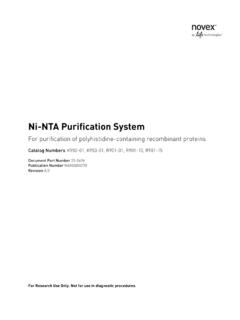Transcription of 10. Reduce Losses in the Transmission and Distribution …
1 10. Reduce Losses in the Transmission and Distribution System10-110. Reduce Losses in the Transmission and Distribution System1. ProfileElectricity Losses occur at each stage of the power Distribution process,1 beginning with the step-up transformers2 that connect power plants to the Transmission system , and ending with the customer wiring beyond the retail meter. The system consists of several key components: step-up transformers, Transmission lines, substations, primary voltage Distribution lines, line or step-down transformers, and secondary lines that connect to individual homes and businesses. Figure 10-1 shows a diagram of these system components. These electricity Losses are often referred to generically as line Losses , even though the Losses associated with the conductor lines themselves represent only one type of electricity loss that occurs during the process of transmitting and distributing electricity. system average line Losses are in the range of six to ten percent on most Power PlantStep UpTransformerStep DownTransformerStep DownTransformerDistributionLinesTransmis sionLinesResidence1 Distribution is, regrettably, an ambiguous term when discussing electric power.
2 As used in this sentence, it reflects the overall process of delivering electricity from power plants (where it is generated) to end-users (where it is consumed by homes, businesses, and institutions). Distribution is also a technical term of art, however, which refers to the lower-voltage, later stages in the electricity delivery process, as illustrated in Figure 10-1. The reader should remain cognizant of the potential for the confusion this ambiguity Transformers are used to increase voltage for more effective transportation of electricity and to decrease voltage back to levels suitable for industrial, commercial, and residential Adapted from: Cowlitz County (WA) Public Utility District. (Undated). Electricity- Transmission (How Electricity Moves). Available at: utility grids, but they increase exponentially as power lines become heavily loaded. Avoiding a small amount of electricity demand in the highest peak hours can Reduce line Losses by as much as 20 percent.
3 At such levels of Losses , disproportionately more generation resources need to be operated to deliver the same amount of electricity to of the stages identified in Figure 10-1 is subject to Losses , and therefore provides opportunity for efficiency improvements. The cumulative benefits can be very signifi-cant. This is because a one-kilowatt (kW) load reduction at the customer s end translates into more than a one-kW load reduction sometimes very much more moving upstream to the Distribution , Transmission , and genera-tion levels because of Losses compounding along the component of the Distribution system can be optimized to Reduce line Losses . This chapter discusses each component, and how equipment choices can affect efficiency Figure 10-1 Simple Diagram of an Electric Transmission and Distribution System3 Implementing EPA s Clean Power Plan: A Menu of Options10-2and, by extension, greenhouse gas (GHG) addition, line Losses can be significantly affected by end-use energy efficiency policies (detailed in Chapters 11 through 15) and demand response programs (Chapter 23).
4 Engineering FundamentalsLosses occur in both Transmission and Distribution lines and in transformers, the fundamental components of the electricity Distribution system or the grid. Some Losses , called core or no-load Losses , are incurred to energize transformers in substations and on the Distribution system . A larger share is labeled resistive or copper Losses ; these Losses reflect the resistance of the materials themselves to the flow of electricity. Core Losses are typically 25 to 30 percent of total dis-tribution Losses , and do not increase (or decrease) with changes in load. They are largely influenced by the char-acteristics of the steel laminations used to manufacture the core of Losses are analogous to friction Losses in the lines and transformers. As loads increase, the wires (including those in the transformers) get hotter, the material becomes more resistive, and line Losses increase. For this reason, resis-tive Losses increase exponentially with the current on a At low-load periods, system Losses are almost entirely core Losses , and may be as low as three During peak electrical demand periods, however, resistive Losses become dominant.
5 At the highest load hours, average line Losses increase into the 10- to 15-percent range, but marginal line Losses (those that are avoided if load is reduced) may increase to 20 percent or more. This concept is analogous to a freeway at rush hour even a small reduction in traffic volumes can produce very large reductions in friction and improve traffic flow. At peak extremes, it can take five power plants operating to provide the end-use electricity normally provided by four. Therefore, line loss reduction is partly a function of system design and construction, but is also heavily affected by operation of the underlying electrical loads and by how well peak loads are managed. Chapters 11 through 15 and 23 address energy efficiency and peak load management, both of which are very important in reducing line chapter necessarily involves technologies and terminology that may be foreign to air quality regulators, but are quite well understood by the utilities that they regulate.
6 Several terms reflecting common units of electrical measurement and their abbreviations are defined below. Amperes (A): A measure of the current flow through lines and transformers. It is analogous to the flow of water through a pipe. Kilovolts (kV): Thousand volts, the unit of measure for generation, Transmission , and Distribution lines. Kilowatt-hour (kWh): A measure of energy or power consumed in one hour. Volts (V): Voltage is what drives current through lines and transformers to end-use appliances in homes and businesses. It is analogous to pressure in a water pipe. Voltage must be delivered within a narrow range of between 110 and 124 volts at all times for residential appliances and equipment to operate properly. Watts (W): A measure of the quantity of power or work (horsepower) that electricity can do at any moment. Watts is the product of amperes multiplied by volts. For example, 220 volts at 20 amps equals 4400 watts, about the amount that a typical residential electric water heater uses.
7 A one-horsepower (1 hp) swimming pool pump motor uses 746 watts. A later section will discuss additional terms, including power factor and reactive power, which slightly modify these units of measurements to reflect the character of electricity usage. Reactive power is measured by volt-amperes (VA) and by volt-ampere reactive (VAR). Key Units for Measuring Electricity4 This is reflected mathematically as I2R, meaning the Losses increase with the square of the current ( I or amperage) multiplied by the resistance (R) of the transformer winding or line Because the current is low, the square of the current is also Reduce Losses in the Transmission and Distribution System10-3 Components of the system That Contribute to LossesEach component of the utility Transmission and Distribution system contributes to Losses , so a loss avoided at the customer s end-use or meter compounds, moving back up the system to the generation level. Table 10-1 below illustrates typical line Losses at each stage below the Transmission receipt point.
8 Transmission system line Losses generally involve two (or more) additional transformation stages and one (or more) additional set of lines. Depending on voltage and distance, Transmission line Losses range from two to five system Losses at every system Conductors. Long-distance Transmission lines bring power from generators to the service territory of the Distribution utility. In the western United States, these distances can exceed 1000 miles (for example, power from the Canadian border to Los Angeles). Although the conductors themselves have low resistance, the length of the lines and the sizing of the conductors affect Losses . Losses along the line may be greatly reduced in direct current (DC) long-distance Transmission systems, making DC Transmission desirable for very long-distance Transmission lines. However, additional Losses of up to percent occur in the converter stations at each end of a DC Transmission Stations. Many utilities have an intermediate step on their systems, with power taken from distributing stations, which receive power at high voltage (230 kV and higher) and deliver that power to multiple Distribution substations at 69 kV or 115 kV.
9 Transformer Losses that occur in substations are incurred twice first in transforming power from high-voltage Transmission to an intermediate voltage, then again at the substations transforming it down to primary voltage. The principal Losses in distributing stations are transformer Losses . The reason utilities use separate voltage levels is to isolate bulk power transfers from power that is serving load. This approach increases system Transformers. These take power from the Transmission system , typically at 115 kV or higher, and convert it to the Distribution voltage levels of 4 kV to 34 kV. Sized specifically for their maximum expected loads, they very seldom carry power near that limit in order to allow for load transfer between circuits, but there are two issues of concern. The first is core Losses that may be too high when they are lightly loaded. The second is resistive Losses that may be too high when they are heavily Regulators. These are transformers with multiple taps installed along Distribution circuits to enable increasing or decreasing voltage at various points.
10 Historically these were installed along long rural Distribution lines to enable a step-up of voltage at distant points, offsetting reduced voltage caused by resistance Table 10-1 Losses at Each Stage of Electricity Distribution6 ComponentTypical UrbanTypical RuralEstimated Loss as a Percentage of Energy SoldSubtransmission Lines Transformers Lines Transformers No Load Transformers Load Lines following section describes each segment of the Transmission and Distribution system , with an indication of how Losses occur and how they can be Transformers. These are the transformers located at generating facilities, which convert the power produced at generating plants to voltages suitable for Transmission lines. Typical large generators produce power at 6600 volts, 13,800 volts, 18,000 volts, or even 22,000 volts, whereas typical Transmission voltages in the United States are 115 kV, 138 kV, 230 kV, 345 kV, 500 kV, and 765 kV.





![SUBCHAPTER 12 [1206.3] 754 Minimum Quantity of LIGHT, …](/cache/preview/b/9/a/6/1/3/9/d/thumb-b9a6139d2a030f344df612206d612d93.jpg)